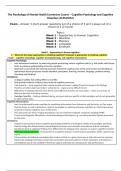Other
Cognitive Psychology and Cognitive Disorders - CLPS11052 - Lecture notes, reading notes, essays, exam preparation
- Course
- Institution
- Book
This document has everything you need for this course, including lecture notes & reading notes from the essential readings for the different topics for this course, as well as 2 pre-written full essays that cover questions that are likely to be in the exam. I put these notes together and revised th...
[Show more]




